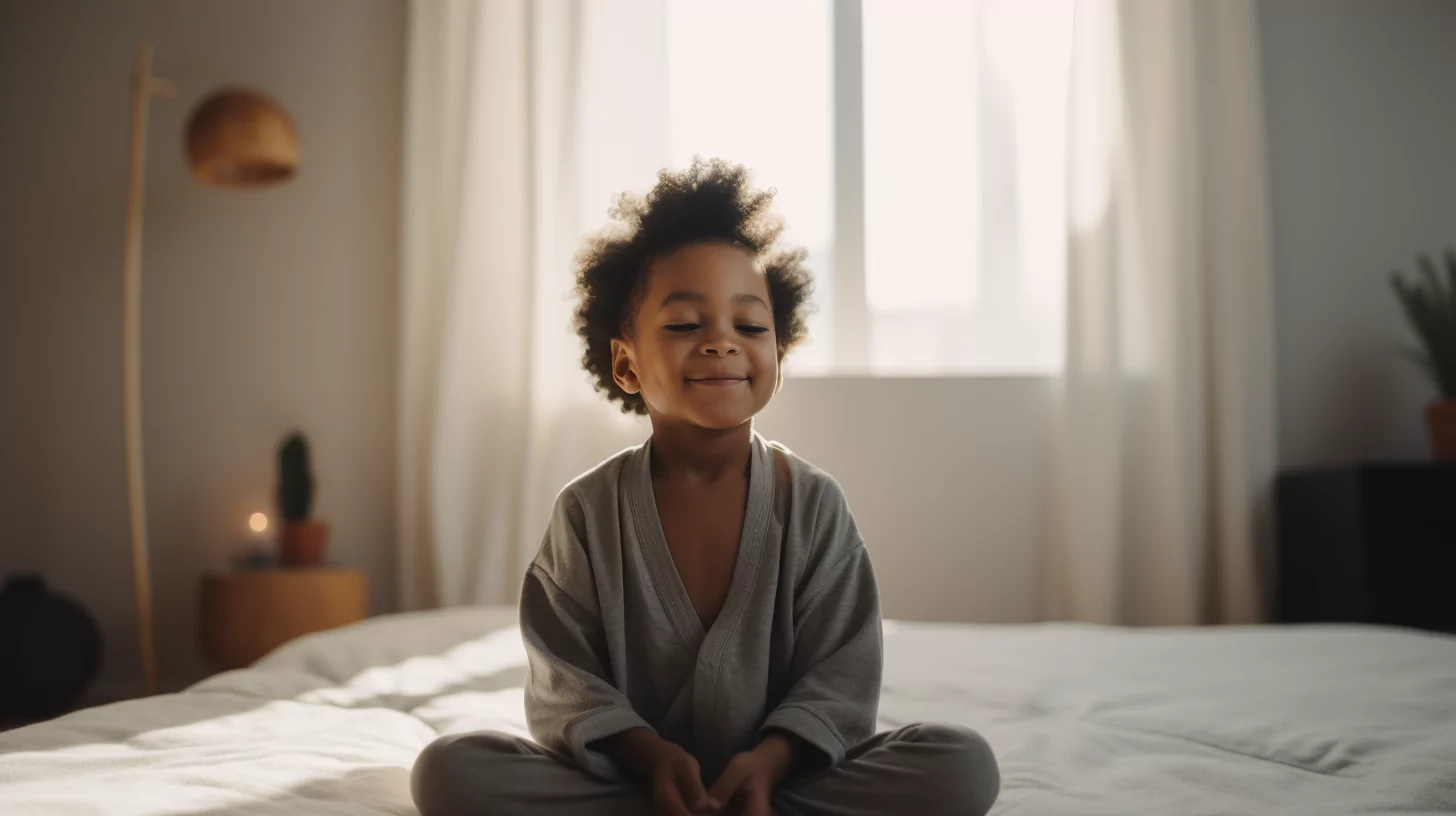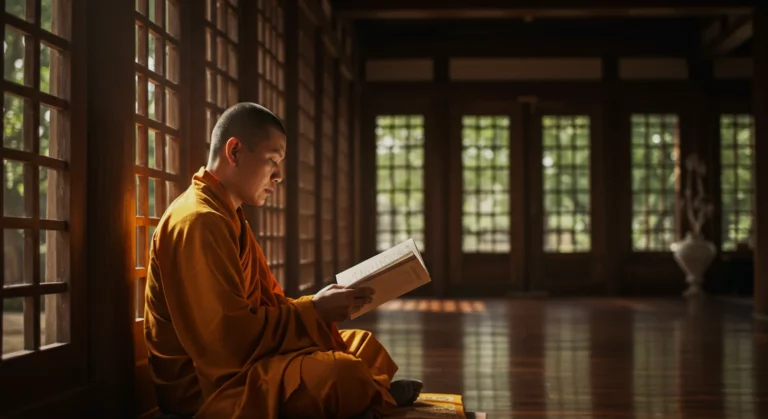Screaming matches between the siblings, one kid (or all) running amok, tantrums being thrown, the tween slamming doors, the teen constantly finding themselves in detention… If there’s anything a parent can relate to, it’s their kid trying to deal with big emotions.
There are many practical techniques that you can use to help your child. One that can really be effective is meditation for kids.
It not only helps them center their awareness, but it also allows them to reap the benefits of meditation from an early age.
After all, children are our future, as Whitney Houston once sang. Teach them well, and they’ll lead the way.
What Is Meditation for Kids?
Calming meditation for children is an excellent practice that helps them develop inner peace and mindfulness. Teaching them to focus on their present thoughts and feelings enables them to understand, distill, and embrace them without judgment.
Introducing it as early as possible can help them develop into happier, more spiritually healthy adults—this is what meditation is all about. And for little humans, this practice has traditionally been approached in an open-hearted and playful manner. That includes:
- Breathing exercises,
- Guided storytelling,
- Creative visualization, and
- Many other techniques.
These contribute to the development of their imagination, creativity, understanding, and calmness. The main focus? Making it an enjoyable experience the child can’t wait to repeat.
Teaching Kids Meditation Is Easier Than We Think
Have you ever watched a toddler eat their food? Before they take a bite of it, they thoroughly examine it—they smell it, take it apart, poke it with their fingers, bite it, and spit it out.
Children naturally exercise mindfulness, a key component of meditation. Since they have fewer mental barriers, biases, and pre-determined beliefs, they manage to experience a pure state of mindfulness.
In contrast, as adults, we believe it takes practice and effort to meditate or achieve mindfulness. That’s happening because we need to consciously rid ourselves of pre-conceived thoughts, fears, and beliefs that inhibit our natural state of awareness.
Kids are going to learn by example. They’re going to do what we do, not what we say. And so if you want your child to be less stressed, the best thing that parents can do is handle their own stress. — @ZivaMeditation Share on XIt may seem odd to think of children as calm, nonjudgmental, and mindful. But, ultimately, children can achieve mindfulness and thereby practice meditation more easily than adults can.
So it’s safe to say that incorporating meditation into a child’s learning process is easier than we think, and schools across the U.S. have begun adding meditation to their curriculum with positive results.
A Baltimore school replaced detention (a conventional way of punishing misbehaving kids) with a more progressive form of behavioral evaluation: meditation. Instead of the painstaking and, in most cases, unhelpful process of detention, teaching kids to focus on their breath and be in the present moment achieves more value in the long run.
Even better, teaching kids outside of detention through school programs or at home can help them avoid the reasons for their detention.
And though research on how meditation affects and benefits kids is not quite as robust and thorough as it is for adults, it’s certainly starting to take off.
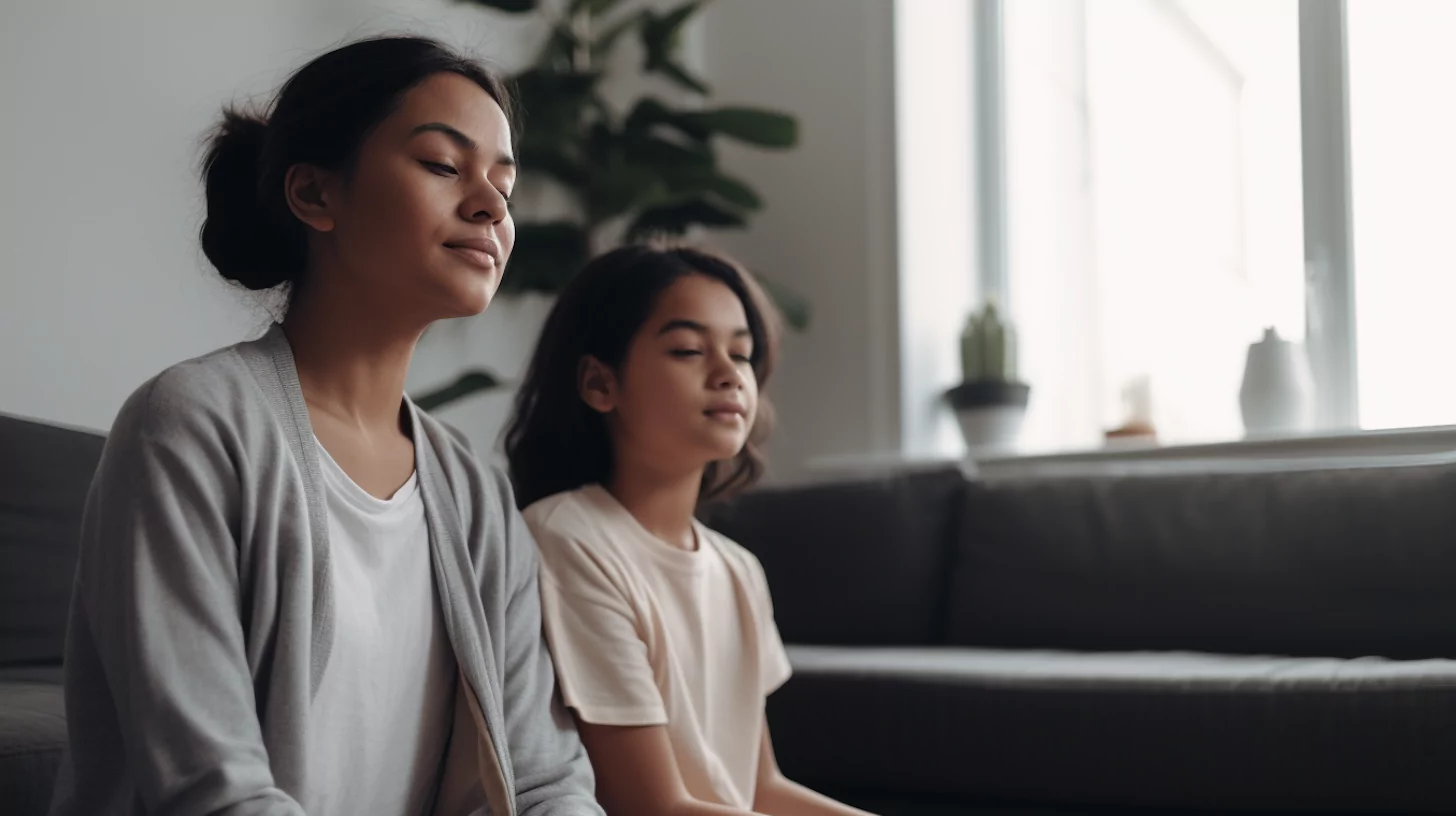
The Impact of Meditation on Children, According to Science
The practice of meditation has garnered significant attention for its positive impact on the well-being of children. Research has shown that it’s not just good for their bodies, but also for their minds and emotions.
Here are some of the most interesting studies on the topic:
Increased attention
Kids’ attention spans always seem to worry grownups. But meditation can help with that.
Research from 2004 found that kids with ADHD who practiced meditation with their parents twice a week had some amazing benefits: concentration at school improved, and other improvements were seen.
It’s also possible to do something called Mindfulness-based Cognitive Therapy for Children (MBCT-C), which research has found to help kids with behavior and attention issues as well as reduce anxiety in kids who previously felt anxious.
Furthermore, in a 2016 study, calming meditation for kids training reduced hyperactive behavior and improved concentration in boys with ADHD. In other words, meditation gives children’s minds superpowers.
Better grades
A study by the University of Louisville revealed that meditation had a positive impact on children during high-stakes testing. Their findings showed that it effectively reduced their anxiety levels and improved their working memory.
Other studies have also indicated that mindfulness training or mindfulness-based stress reduction (MBSR) can boost school achievement. However, further research is needed to gain a comprehensive understanding of how meditation can be applied to education.
Improved mental health
Meditation is turning out to be a real gem for helping kids with their mental health, just like it does for adults. A notable study showed a reduction in anxiety symptoms among kids with high anxiety after a 12-week treatment focusing on mindfulness-based cognitive therapy for children (MBCT-C).
“Children, to me, it’s more about planting the seed,” Emily Fletcher, the founder of Ziva Meditation and trainer of Mindvalley’s The M Word Quest, says. “It’s more about showing them what’s possible. It’s about letting them know that they have the ability to turn inward for their kindness, their bravery, their creativity.”
A yoga and meditation program after school was also found to increase children’s feelings of happiness and relaxation. Also, yoga alone has been shown to reduce anxiety, depression, and fatigue compared to physical education alone.
The findings suggest that meditation can have positive effects on children’s mental well-being even if the research is still in its early stages, paving the way for further exploration.
Empowering children’s emotional awareness
Self-regulation is inextricably linked to mindfulness.
When kids learn to be mindful, they can actually get better at controlling their emotions and behaviors. It’s like a superpower to understand their own thoughts and reactions in the moment.
If we help our little ones become aware of their feelings and thoughts, we won’t leave them to figure out this internal world all by themselves. And that’s a skill many adults wish they had learned as kids.
This idea is backed up by research: eight weeks of training twice a week involving Mindful Awareness Practices (MAPs) improved executive function in kids.
5 Benefits of Meditation for Children
While the benefits of meditation are very well known for adults, what are they for children?
Let’s look at the top five.
1. Meditation enhances focus
Have you noticed how kids are drawn to gadgets, social media, and technology more than we ever were in our youth? Modern-day demands increasingly challenge us to think and respond more quickly than ever before, and kids are no exception.
Constant stimulation during their waking hours—from the internet, video games, social media, and school assignments—demands them to multitask and jump from thought to thought. While this may sometimes be a good thing, there is no doubt that you want your child to have the capacity to focus.
A study by Italian neuroscientist Giuseppe Pagnoni shows that meditation changes brain patterns as well as enhances mental focus, which could lead to better cognitive performance. Compared to non-meditators, those who meditated had lower activity in the ventral posteromedial cortex, the part of the brain associated with spontaneous thoughts and mind-wandering.
So the next time your child needs a little boost in focus and clarity, look no further than a simple meditation.
2. Meditation fosters self-esteem and self-love
Think back to when you were a kid. Did you, at one time or another, feel like you weren’t “good enough”?
Childhood, especially during puberty, can be tough and, in a lot of cases, debilitating to self-esteem and confidence. Naturally, present insecurities may have stemmed from childhood:
An embarrassing situation that haunted you…
Not being the “cool kid” at school…
Not having “that” car…
Being bullied…
…Or any childhood situation that imprinted trauma or any negative belief about yourself.
Thankfully, meditation provides access to a greater feeling of inner stability and security.
“We have to give kids the freedom and, more importantly, the safety to feel the entirety of their emotions”, says Emily.
As a practice to quiet your mind, meditation slows down the mind’s activity (self-talk and obsessive thinking) to experience relaxation, inner peace, self-love, and joy. And when you learn to focus on the moment, your fears, self-doubt, and insecurities are transformed.
3. Meditation relieves stress for peak performance
Stress can impact children starting at a very young age. And stressful situations affect health and well-being almost immediately.
Demands from academic studies, competition, and always having to “do things right” play a huge toll on kids’ ability to relax. Bluntly put, too much stress inhibits peak performance.
Like adults, meditation can help children cope with stresses and traumas by being mindful of present situations and thinking clearly and rationally about them.
When the mind is calm, the body follows. When the mind is free of tension, it will function at its peak.
Since meditation is known to help kids focus their energies and reduce tension, overwhelming evidence suggests that it can help them perform better in school. In fact, meditation can have a profound impact on not only academic but also athletic, creative, and social performance.
A University of California, Los Angeles study researched second and third-graders who practiced “mindful” meditation techniques for 30 minutes twice a week for eight weeks. Their findings showed that these youngsters had improved behavior and scored higher on tests requiring memory, attention, and focus than the non-meditators.
More and more schools are incorporating meditation into their learning programs. And it’s only a matter of time before meditation becomes the norm for education programs.
4. Meditation supports healthy emotional development
In our fast-paced lifestyle, children are having to face even more “fears” than ever before. Fears of not being accepted, fears of too much change, fears of losing loved ones, or simply fears of not being “enough.”
We want kids to be able to navigate through phases of insecurity, frustration, and impatience without too much distress. But prolonged fear-based stress on a child’s emotional development can be debilitating and have long-term repercussions.
Meditation allows children to access their natural rhythm of self-awareness and mindfulness. These are two key components of self-soothing, problem-solving, patience, and facing fears.
By teaching meditation to your own children, you can help them become aware of this natural state. And that can, consequently, help them overcome any obstructive, negative emotions.
5. Meditation enhances empathy and connectedness
It’s commonly known that meditation increases compassion. And empathy and compassion directly stem from the awareness state of the mind, a distinct outcome of mindfulness meditation.
But there’s now tangible, scientific evidence of how mindfulness meditation increases kindness, compassion, and connectivity among adults and children alike.
In a study at Northeastern University, researchers found that “meditation made people willing to act virtuous—to help another who is suffering—even in the face of a norm not to do so.”
Researchers are uncertain of exactly why this mindfulness practice heightens empathy and connectedness. But there are two possible reasons.
- First, it improves children’s attention span and their ability to focus on specific things in their environment.
- Second, it creates neural pathways that allow children to see the interconnectedness of human suffering, regardless of their relationships.
And when it’s practiced on the regular, meditation builds self-love, compassion, and human or environmental connection on multiple levels.
Challenges and Considerations in Teaching Meditation to Kids
Theory is one thing, but the reality is, teaching meditation to kids can present its own set of challenges. Here are a few reasons why:
- Their attention spans aren’t long. Unlike adults, children may find it challenging to sit still and focus on their breath or thoughts for prolonged periods. So, for kids to remain engaged and motivated during meditation, educators and parents need to apply creative and interactive methods. These can include storytelling, playful visualization, and simple movements.
- Adapting meditation techniques to children’s developmental stages and individual needs. Limited attention spans are one thing, but understanding complex mindfulness concepts is another. Mindfulness meditation for kids can be an effective tool for improving their mental and emotional health when it is balanced between age-appropriate practices and personal growth.
- Environment and cultural context can have a strong influence on their openness and willingness to meditate. It might also be difficult for parents or caregivers who do not meditate themselves to support and encourage their kids’ meditation practices.
While it’s evident that meditation can have quite an effect on emotional intelligence, resilience, and mental wellness in kids, overcoming cultural barriers and misconceptions about this mindfulness practice is vital.
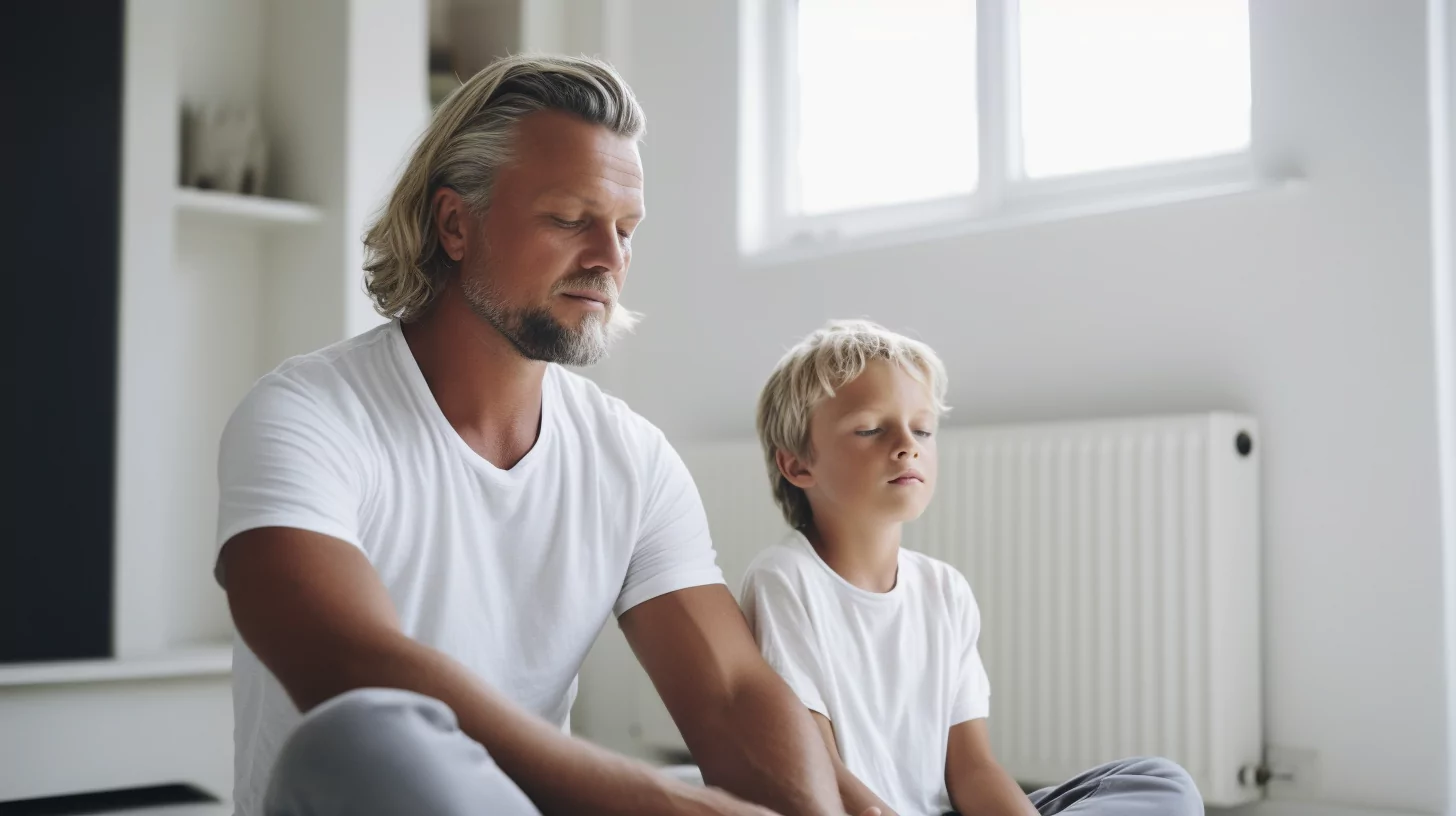
Meditation Tips and Techniques for Kids
Let’s face it: Kids learn differently than adults do. So an effective approach for kids to meditate often differs from the way adults approach it, and that’s completely fine.
Here are a few tips to help you encourage your children to incorporate meditation into their lives:
- Kids learn by watching, observing, and really soaking in the moment. All eyes are on you, so be sure to set a solid example of how to incorporate meditation into your daily life.
- You can start by dedicating a special area in your home or school for regular meditative practice. Make sure it’s comfortable and free of distractions.
- Children learn well with games and fun exercises. So you can start by playing a game of who can be the quietest or by doing breathing exercises that incorporate following a fun rhythm or playful music.
- Since children often have a set routine, schedule daily quiet time, so they can anticipate incorporating meditation each day. You can start with just five minutes per day and gradually increase from there.
In time and with dedicated practice, kids will start to look forward to this calming space of quiet and relaxation.
Top 10 Guided Meditations For Children
If you’re new to meditation yourself or you simply want more guidance to help your child start a regular meditation practice, worry not. Simple guided meditations can ease your child into getting the full benefits of meditation anytime and anywhere.
Below are 10 guided meditations for kids, handpicked just for you. And for best results, have your kids try these guided meditations with headphones.
1. Soothing Morning Meditation
Time: 20 Minutes
Recommended for: Kids during awakening
During this morning meditation, you will calmly awaken your child and prepare it for the day ahead. Through the use of a relaxing, female voice, this mindfulness meditation for kids will boost mindfulness and connect them with cosmic energy.
Experience it:
2. Snowman Relaxation for Kids
Time: 7.5 Minutes
Recommended for: Kids during bedtime
This winter-themed meditation is guided by an enthusiastic female voice, making it almost story-like. Your kids will imagine themselves as snowmen, warming up and relaxing as the sun warms and soothes the tensions and worries they have.
Experience it: Snowman Relaxation for Kids
3. Children’s Rainbow Meditation
Time: 5 Minutes
Recommended for: Pre-schoolers
This five-minute meditation is perfect for little ones who are trying meditation for the first time. Bird imagery, visualizations of the colors of the rainbow, a soothing female voice, and calming music make it easy to find peace and calm.
Experience it:
4. Mindful Breathing for Kids
Time: 6 Minutes
Recommended for: Children ages 6–10
Annaka Harris has created several guided meditations for children ages 6–10. In this six-minute mindfulness meditation, Annaka guides kids toward heightened self-awareness and relaxation through simple breathing exercises.
Experience it:
5. Mindful Hearing for Kids
Time: 5 Minutes
Recommended for: Kids to pay attention to their surroundings
Another Annaka Harris meditation—this time, this audio meditation guides kids to pay attention to surrounding sounds and what it feels like to really listen and be in the moment.
Experience it: Mindful Hearing
6. Guided Relaxation for Children
Time: 7.5 Minutes
Recommended for: Children ages 5 and older
Kids feel anxiety and stress just like we all do, and meditation is a quick and easy way to feel safe and secure.
This short guided audio meditation, led by a female voice and available without background music, focuses on the breath and “letting go.”
Experience it:
7. Magic Book Relaxation
Time: 18 Minutes
Recommended for: Children of all ages
This guided audio meditation uses playful imagery and visualization techniques to access inner peace and joy.
The soothing female voice paints a story-like journey of discovering a magic book and experiencing an exciting, magical wonderland.
Experience it:
8. Bouncing Ball Mindfulness
Time: 12 Minutes
Recommended for: Children of all ages
This audio meditation guides the children to achieve full awareness and mindfulness by using a special visualization exercise of following a bouncing ball. The audio can also be used to lull your child’s mind into a deep slumber.
Experience it: Bouncing Ball Mindfulness
9. Magic Forest Meditation
Time: 12.5 Minutes
Recommended for: Children of all ages
Visit magical landscapes and animals in this meditation adventure for a much-needed mental vacation. Kids can select their preferred imagery to enhance their experience.
This audio meditation is great for kids who love animals and nature.
Experience it: Magic Forest Meditation
10. Whirly Burly Snow Storm Meditation
Time: 4.5 Minutes
Recommended for: Children ages 3–7
Modern-day living can often make kids feel like they are caught in a snowstorm, where they feel stressed and can’t think clearly. Calm the snowstorm by having your child tune into beautiful sounds, breathwork, and visualization techniques.
This guided meditation is great for kids who need a quiet moment to feel peaceful, secure, and relaxed.
Meditation Music For Kids
There are so many moving parts, constant demands, and stimulations in today’s world. And music provides an easy escape.
Allow your kids to find inner peace and calmness through these comforting sounds and music. They can simply listen to these tunes or use them as background music during meditation.
1. Sea Relaxation: Deep Meditation Music for Kids
Time: 55 Minutes
Enjoy the relaxing sounds of the sea against the stunning backdrop of a beach in Sardinia, Italy, to access deep stillness and calm. This YouTube video is excellent if your kids have a (almost) full hour to unwind and meditate.
Experience it: Sea Relaxation: Deep Meditation for Kids
2. Meditation Music for Kids and Chakra Healing
Time: 2 hours, 15 Minutes
This meditation track consists of soothing wind chimes, vocals, and the sounds of a gurgling stream. They’ll be lulled into a blissful, deep, meditative state—perfect for bedtime or as they sleep.
Experience it: Meditation Music for Kids and Chakra Healing
3. Deep Meditation Music for Kids
Time: 31 Minutes
Inspiring orchestral music enhances all types of meditation in this meditation music track.
The moving music is reminiscent of popular movie soundtracks and allows them to access a deeply emotional and contemplative state of mind—great for practicing gratitude and mindfulness.
Experience it: Deep Meditation Music for Kids
4. Quiet Music For Learning and Relaxing
Time: 14.5 Minutes
Celestial and trance-like, this music for meditation can be used for enhanced focus (i.e., when studying or learning) or to take a moment for mindfulness and self-awareness.
Momentary sounds of crashing waves and bubbles, coupled with space-like tones, almost make this meditation music other-worldly.
Experience it: Quiet Music for Learning and Relaxing
5. Calming Music For Children
Time: 5 Minutes
Have your kids enjoy a moment of calm and relaxation with this beautiful meditation music track. Rich nature imagery and soothing sounds instantly bring the mind to a state of peace and serenity.
Experience it: Calming Music for Children
6. Relaxing Music for Children
Time: 51 Minutes
Calming music is an excellent way to help calm the mind and rest the body and can be enjoyed by everyone of all ages—even babies. This lullaby-like meditation music is perfect to play during your baby’s bedtime—in the crib or in your arms.
Experience it: Relaxing Music for Children
7. Pereehali by Dmitry Evgrafov
Time: 3-5 Minutes (for each track)
Even a couple of minutes of peace and tranquility can bring a whole new wave of relaxation, perspective, and a positive mindset.
Gentle modern classical piano music by Russian composer Dmitry Evgrafov can be enjoyed as seven individual 2-3-minute tracks or in its entirety as an album.
Experience it: Pereehali by Dmitry Evgrafov
8. Shri Saraswati Song: “Mother, You Are My Guru”
Time: 4 Minutes
This playful playlist of Sahaja Yoga songs is an amazing creation for bonding with your child—love, innocence, and joy flow through each word. Substitute common nursery rhymes with these joyful songs.
Experience it: Shri Saraswarti Song: “Mother You Are My Guru”
9. Meditation Music Flute: Sahaja Yoga
Time: 15 Minutes
This meditation is another relaxing song in the series of Sahaja Yoga music. It was designed to help silence the mind and see all the beauty behind it. And as a result, it can help boost meditation focus and self-awareness.
Experience it: Meditation Music Flute: Sahaja Yoga
10. Dreamy Cat
Time: 2.16 minutes
This soothing, relaxing song can instantly put a smile on your child’s face (and on yours). Especially good for times of stress or anxiety, it’s a sure way to lift your spirit with its soft, familiar tunes.
Experience it: Dreamy Cat
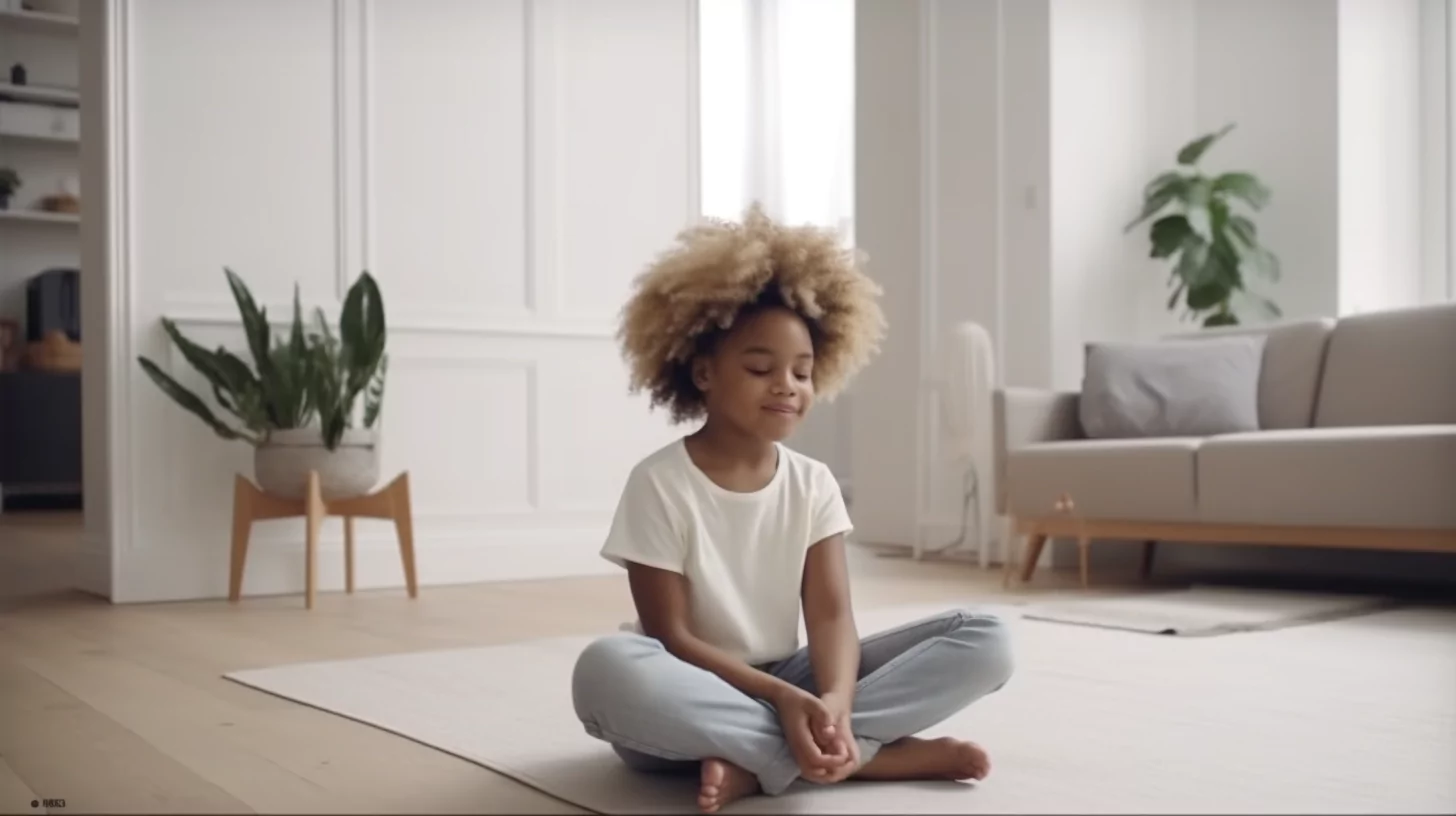
Greatness Starts With Mindfulness
We meditate to get good at life, not to get good at meditation. — @ZivaMeditation Share on XSo if you’re looking to help your child get “good at life,” there’s no better place to start their meditation practice than at Mindvalley.
Download the Mindvalley app and sign up for a free account. With it, you’ll get daily guided meditations that you can do with your child (or they can do on their own).
What’s more, you’ll have access to the first few lessons of meditation quests like Emily’s, so you can better understand what it takes to foster mindfulness, compassion, and emotional intelligence in your little ones.
Their greatness starts with being mindful. And their mindfulness can start with meditation.
Welcome in.
—
Images generated on Midjourney.
